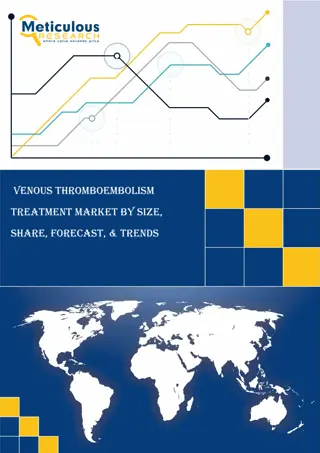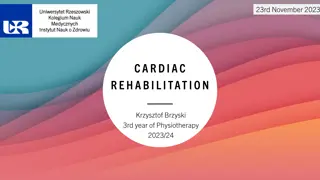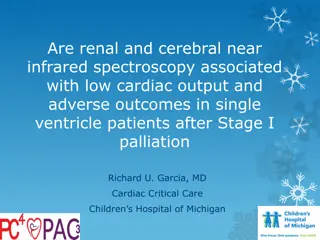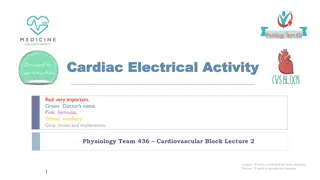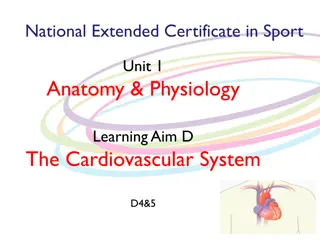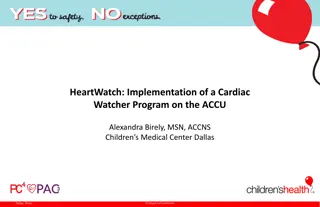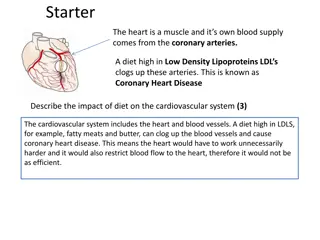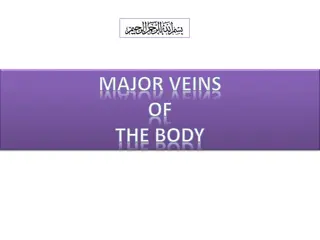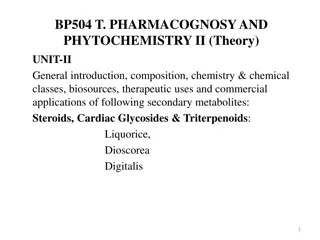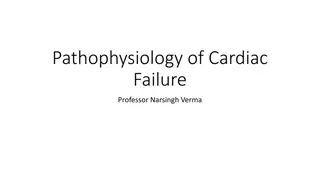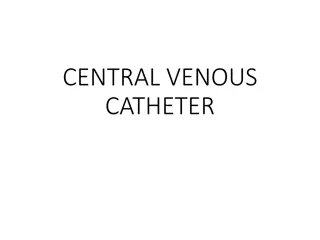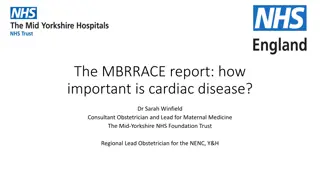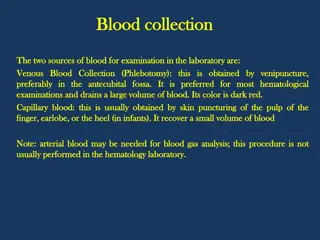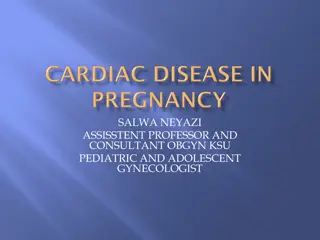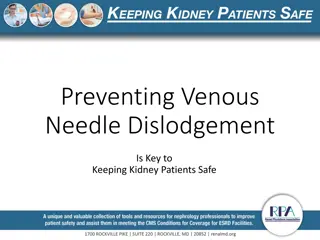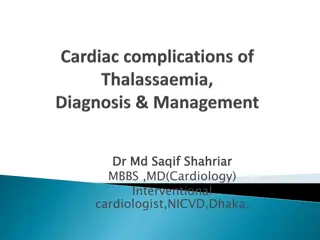Understanding Cardiac Output and Venous Return in Cardiovascular Physiology
Cardiac output, stroke volume, end-diastolic and end-systolic volumes play vital roles in cardiovascular function. Factors affecting cardiac output include physiological conditions and pathological states like hyperthyroidism and myocardial infarction. Venous return, controlled by mechanisms like Frank-Starling's law and tissue metabolism, is crucial for determining cardiac output. Changes in heart rate, contractility, preload, and afterload can impact stroke volume. Maintaining appropriate heart rate is essential for optimal cardiac output, with interventions like pacemaker implantation sometimes necessary.
Download Presentation

Please find below an Image/Link to download the presentation.
The content on the website is provided AS IS for your information and personal use only. It may not be sold, licensed, or shared on other websites without obtaining consent from the author. Download presentation by click this link. If you encounter any issues during the download, it is possible that the publisher has removed the file from their server.
E N D
Presentation Transcript
By the end of this lecture the students are expected to: Define cardiac output, stroke volume, end- diastolic and end-systolic volumes. Define physiological conditions affecting CO List causes of high and low output pathological states. Define venous return and describe factors controlling venous return
Cardiac output is the amount of blood pumped by each ventricle per minute (5L/min). It varies physiologically with age, body mass index, physical activity, sleep, meals, pregnancy, etc.. But there are pathological conditions that lead to a significant increase in CO including hyperthyroidism, anemia and conditions decreasing CO as myocardial infarction. CO is well controlled and regulated by Many Factors: venous return, ABP , blood volume and nervous regulation. This lecture will focus on Venous return as an important factor determining CO. Venous return represents the amount of blood returning to the heart per minute. Venous return is controlled by many factors:1) Frank- Starling s mechanism, 2) mean systemic filling pressure, 3) tissue metabolism, 4) thoracic pump, 5) Gravity, 6) Muscle pump, 7) blood volume.
Cardiac output: Cardiac output: : : Amount of blood pumped by each ventricle per minute. Stroke volume (SV): Stroke volume (SV): Volume of blood ejected by each ventricle/beat. CO = SV x HR CO = SV x HR Stroke volume is expressed in ml/beat and heart rate in beats/minute. Therefore, cardiac output is in ml/minute. Cardiac output may also be expressed in liters/minute.
End Amount of blood remaining in the heart by the end of diastole. 140 mL End Amount of blood remaining in the heart by the end of systole. =70 mL SV = EDV End- -diastolic volume (EDV): diastolic volume (EDV): End- -systolic volume (ESV): systolic volume (ESV): SV = EDV- -ESV ESV
SV = EDV - ESV. This measurement can be affected by changes in the heart's ability to contract, the force of contraction, the volume of blood available to be pumped or other variables such as resistance within the circulatory system that can affect or alter these factors. Severe hemorrhage or shock, heart damage or extreme infections can change the heart's ability to pump effectively. It is affected by cardiac contractility, preload, and afterload.
When heart rates become excessively fast, the heart may not have enough time to adequately fill with blood between beats; this can result in a decreased cardiac output. When heart rates are too slow the cardiac output can also decrease significantly, and interventions may be required to increase the heart rate. Implanted pacemakers may be surgically placed to ensure a consistent adequate heart rate.
Exercise (up to 700%) Eating ( 30%) High environmental temperature ( ) Pregnancy ( ) Anxiety ( 50-100%) Sympathomimitics, epinephrine ( ) Sitting or standing from lying position ( 20- 30%)
Increasing CO: Fever Hyperthyroidism Anemia Decreasing CO: Hypothermia. Hypothyroidism Myocardial diseases e.g. infarction, failure Rapid arrhythmias
Venous return Heart rate Stroke volume Blood volume. ABP Neural factors
How is cardiac output regulated?
Initial stretching of the cardiac myocytes prior to contraction. Is the "load" that the heart must eject blood against i.e. aortic pressure
Affected by: Preload. Afterload Cardiac contractility
Venous return (Preload): It represents the amount of blood returning to the heart per minute. Venous return is controlled by many factors: 1) Frank-Starling s mechanism, 2) mean systemic filling pressure, 3) tissue metabolism, 4) thoracic pump, 5) Gravity, 6) Muscle pump, 7) blood volume.
VR CO VR CO
Under steady-state conditions, venous return must equal cardiac output (CO) because the cardiovascular system is essentially a closed loop. Otherwise, blood would accumulate in either the systemic or pulmonary circulations.
VR EDV stretching of vent.fiber SV VR EDV SV Mechanism: Frank Aability of the heart to pump all blood coming to it without allowing systemic stasis, within limits Frank- -Starling mechanism: Starling mechanism: It acts by increasing the sarcomere length & force of contraction of the cardiac muscle.
Skeletal Muscle contraction: muscle pump mechanism. Venous compliance. Or mean systemic filling presure. Sympathetic activation of veins decreases venous compliance. What is the effect of removal of sympathatic activity to veins?
Respiratory activity. (Thoracic pump) During inspiration the venous return increases because of a decrease in right atrial pressure. Vena cava compression Vena cava compression. An increase in the resistance of the vena cava, as occurs when the thoracic vena cava becomes compressed during a Valsalva venous return. Valsalva maneuver maneuver or during late pregnancy, decreases
Gravity Gravity. Total tissue metabolism. Total tissue metabolism. Blood volume. Muscle pump Blood volume. Muscle pump
Afterload can be defined as the "load" that the heart must eject blood against. In simple terms, the afterload is closely related to the aortic pressure aortic pressure.
An increase in afterload, lead to an increase in end-systolic volume and a decrease in stroke volume. An increase in afterload shifts the Frank- Starling curve down and to the right (from A to B). Explanation:, an increase in afterload decreases the velocity of fiber shortening which reduces the rate of volume ejection so that more blood is left within the ventricle at the end of systole (increase end-systolic volume) A decrease in afterload shifts the Frank-Starling curve up and to the left (A to C)
1. Nervous: -Sympathetic: HR & SV. - -Parasympathetic: HR 2. Chemical -Potassium -Calcium. -Thyroxin. -Catecholamine.
Increase: -Stronger - -Increased total blood volume - -Increased venous tone. - -Increased - -Increased negative Decrease: Standing Increased Decreased ventricular compliance Increase: Stronger atrial Increased total blood volume Increased venous tone. Increased sk Increased negative intrathoracic Decrease: Standing Increased intrapericardial Decreased ventricular compliance atrial contraction. contraction. sk m pump. m pump. intrathoracic pressure. pressure. intrapericardial pressure. pressure.




